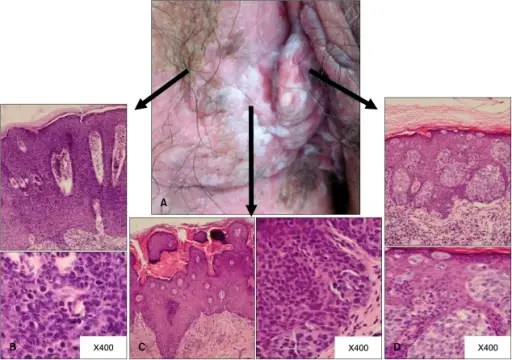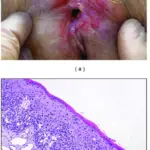Extramammary paget disease of the vulva is an unusual kind of skin cancer that arises from glandular cells or very rare malignancy originating in vulvar apocrine-gland-bearing skin cells.
What is the Pathology of Vulvar Extramammary Paget Disease?
The pathology of vulvar extramammary paget disease is:
-Etiology: The cause of vulvar extramammary paget disease is unknown but could arise from intraepidermal neoplasm from the apocrine gland ducts or pluripotent keratinocyte stem cells.
-Genes involved: TP53, ERBB2, and PIK3CA mutations.
-Pathogenesis: The sequence of events that lead to vulvar extramammary paget disease are: epidermis becomes infiltrated with neoplastic cells causing glandular differentiation due to which the tumor cells arise from these glands.
-Morphology: The morphology associated with vulvar extramammary paget disease shows eczema, with red, scaly patches.
-Histology: The histology associated with vulvar extramammary paget disease shows polyhedral intraepithelial cells.
How does Vulvar Extramammary Paget Disease Present?
Patients with vulvar extramammary paget disease typically women from 50 to 80 years age. The symptoms, features, and clinical findings associated with vulvar extramammary paget disease include: vulvar pain, itching, irritation, burning and scaly plaques on vulva.
How is Vulvar Extramammary Paget Disease Diagnosed?
Vulvar extramammary paget disease is diagnosed by biopsy, cystoscopy, sigmoidoscopy, physical examination.
How is Vulvar Extramammary Paget Disease Treated?
Vulvar extramammary paget disease is treated by surgery, radiation therapy, photodynamic therapy, laser therapy and application of imiquimod cream.
What is the Prognosis of Vulvar Extramammary Paget Disease?
The prognosis of vulvar extramammary paget disease is good. The 5-year survival rate is 75–95%.



